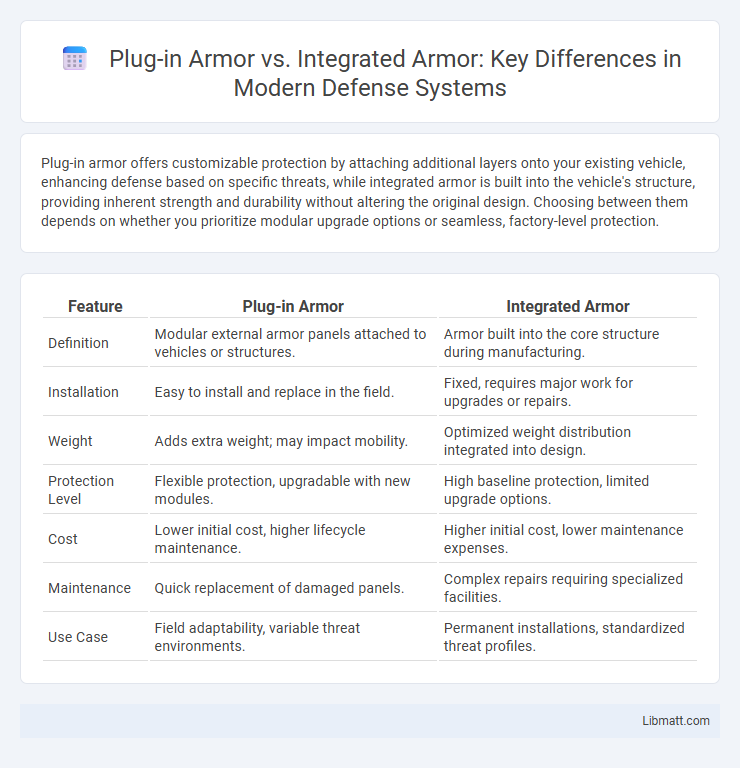Plug-in armor offers customizable protection by attaching additional layers onto your existing vehicle, enhancing defense based on specific threats, while integrated armor is built into the vehicle's structure, providing inherent strength and durability without altering the original design. Choosing between them depends on whether you prioritize modular upgrade options or seamless, factory-level protection.
Table of Comparison
| Feature | Plug-in Armor | Integrated Armor |
|---|---|---|
| Definition | Modular external armor panels attached to vehicles or structures. | Armor built into the core structure during manufacturing. |
| Installation | Easy to install and replace in the field. | Fixed, requires major work for upgrades or repairs. |
| Weight | Adds extra weight; may impact mobility. | Optimized weight distribution integrated into design. |
| Protection Level | Flexible protection, upgradable with new modules. | High baseline protection, limited upgrade options. |
| Cost | Lower initial cost, higher lifecycle maintenance. | Higher initial cost, lower maintenance expenses. |
| Maintenance | Quick replacement of damaged panels. | Complex repairs requiring specialized facilities. |
| Use Case | Field adaptability, variable threat environments. | Permanent installations, standardized threat profiles. |
Introduction to Plug-in Armor and Integrated Armor
Plug-in armor consists of modular plates attached externally to a vehicle, offering flexible protection that can be replaced or upgraded as needed. Integrated armor is built into the vehicle's structure during manufacturing, providing a seamless blend of protection and structural integrity. Your choice between these armor types impacts maintenance, weight distribution, and adaptability on the battlefield.
Defining Plug-in Armor: Features and Functionality
Plug-in armor refers to modular, attachable armor plates designed for quick installation and removal on vehicles or equipment, enhancing protection without permanently altering the base structure. Its key features include adaptability, ease of replacement, and the ability to upgrade defense capabilities based on mission requirements. Functionality centers on providing flexible defense solutions that can be customized to varying threat levels while maintaining operational mobility.
Integrated Armor: Overview and Key Characteristics
Integrated armor offers seamless protection by embedding the armor material directly into the vehicle's structure, enhancing durability and reducing overall weight compared to plug-in armor. This method improves tactical efficiency by eliminating gaps between armor plates, providing continuous ballistic resistance while maintaining structural integrity under impact. Your vehicle benefits from increased survivability and lower maintenance requirements due to the cohesive design of integrated armor systems.
Protection Levels: Comparing Plug-in and Integrated Solutions
Plug-in armor offers modular protection levels that can be upgraded or replaced based on mission requirements, whereas integrated armor provides a fixed defensive layer built directly into the vehicle's structure. Plug-in systems allow for tailored protection against specific threats, enhancing your adaptability in dynamic combat environments. Integrated armor ensures consistent baseline defense with structural rigidity, but lacks the flexibility of rapid upgrading found in plug-in solutions.
Weight and Mobility Considerations
Plug-in armor adds modular protective plates to a vehicle, increasing overall weight and potentially reducing mobility due to added mass and altered balance. Integrated armor, designed as part of the vehicle's original structure, distributes weight more efficiently, maintaining optimal mobility and maneuverability. Vehicles with integrated armor typically achieve better fuel efficiency and mobility performance compared to those relying on plug-in armor kits.
Maintenance and Repair: Ease of Upkeep
Plug-in armor offers easier maintenance and repair through modular panels that can be quickly replaced or upgraded without extensive disassembly, reducing downtime and labor costs. Integrated armor, being built into the vehicle's structure, requires more complex procedures for repair, often involving specialized tools and longer service times. The modular nature of plug-in armor enhances operational readiness by streamlining upkeep processes and enabling rapid damage response in the field.
Cost Analysis: Affordability and Lifecycle Costs
Plug-in armor generally offers lower upfront costs and faster installation compared to integrated armor, making it a more affordable solution for immediate vehicle protection upgrades. Integrated armor, while more expensive initially due to structural modifications, provides enhanced durability and often reduces long-term maintenance and replacement expenses, leading to optimized lifecycle costs. Evaluating the total cost of ownership, including installation, maintenance, and durability, is crucial for determining the most cost-effective armor approach.
Tactical Flexibility and Modularity
Plug-in armor provides tactical flexibility by allowing rapid customization and upgrading of protection levels based on mission requirements, enabling You to adapt your vehicle effectively in diverse combat scenarios. Integrated armor offers modularity through its built-in design, delivering consistent protection without the need for external attachments but limiting quick field modifications. Choosing between plug-in and integrated armor depends on balancing the need for adaptable defense with structural reliability and ease of maintenance.
Real-World Applications and Case Studies
Plug-in armor offers modular protection for military vehicles, enabling rapid upgrades and repairs in diverse combat scenarios, as demonstrated by the U.S. Army's Stryker brigades in Afghanistan. Integrated armor, embedded during vehicle manufacture, provides a uniform defense layer, exemplified by the Abrams tank's composite armor, which balances weight and durability for frontline engagements. Your choice between plug-in and integrated armor depends on mission flexibility, maintenance capabilities, and threat environment statistics from recent battlefield analyses.
Final Assessment: Choosing the Right Armor Solution
Plug-in armor offers modular customization and ease of replacement, ideal for vehicles requiring rapid adaptability and maintenance in combat zones. Integrated armor provides a seamless, weight-efficient protective layer, enhancing structural integrity and long-term durability for armored vehicles designed with fixed protection parameters. Selecting the right armor solution depends on mission-specific needs, balancing flexibility with performance and lifecycle costs.
plug-in armor vs integrated armor Infographic

 libmatt.com
libmatt.com